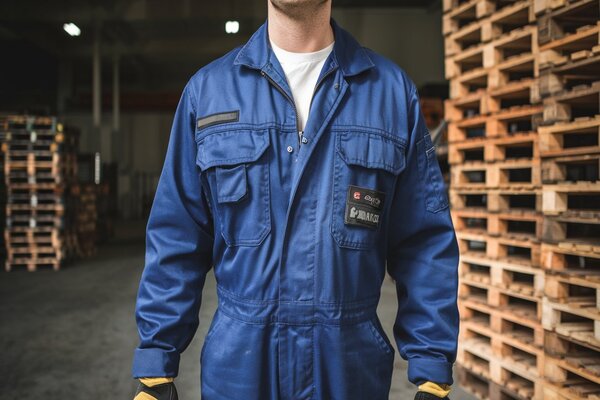The Future of Industrial Workwear in India: Safety & Sustainability
India's industrial landscape is changing quickly, and with it, the clothes worn by its labour force. Functionality and protection are no longer the only considerations for industrial workwear. It now represents creativity, sustainability, and forward-thinkingness.
Workers are wearing uniforms that not only keep them safe but also help create a more sustainable and greener future in factories and construction sites. The development of wearable technology and material science has made the future of industrial workwear in India seem more hopeful than it has ever been.
Factors Influencing Industrial Workwear's Development
Several important elements are reshaping the Indian industrial workwear market:
1. Improved Health and Safety for Employees
Employers now place a high premium on the health and safety of their employees. Modern workwear aims to improve the worker's overall well-being rather than only providing protection. New benchmarks are being set by innovations such as temperature-regulating textiles, fall warning devices, and exposure tracking integrated into uniforms.
2. Material Science Advancements
The capabilities of workwear are being redefined by developments in material science. Better fabrics with better breathability, durability, and comfort are being created. These materials are perfect for the demanding environments of industrial settings since they not only withstand fires and chemicals but also offer improved protection against environmental risks.
3. Expanding Environmental Knowledge
Global environmental concerns are driving up demand for sustainable workwear. Indian enterprises are increasingly using eco-friendly materials and production practices. This shift reflects a broader trend in business towards sustainability across the board, including frequent uniform wear by staff.
4. Using Modifiable Technology in
The impact of wearable technology is being noticed by the workwear industry. The everyday lives of industrial workers are being revolutionised by wearable technology, which includes smart textiles that respond to environmental changes and sensors that monitor health data. This technology boosts productivity in addition to improving safety by giving real-time data and alarms.
The Modern Industrial Workwear Trend
What does industrial workwear in India have ahead of it? A sneak peek at a few of the most noteworthy advancements is provided below:
a). Sensor-Embedded Smart Textiles
Consider wearing clothes that can track body temperature and vital indications like heart rate. By warning managers of possible health hazards, these smart textiles can stop accidents before they start. This invention has the potential to revolutionise fields where worker safety is crucial.
b). Wearable assistance systems and exoskeletons
Science fiction no longer exists for exoskeletons. By offering physical support, these wearable gadgets lessen the discomfort associated with repetitive activities and heavy lifting. This results in less weariness and a decreased chance of injury for industrial workers, creating a safer and more productive work environment.
c). Clothing That Is Adaptive and Self-Regulating
Imagine wearing a garment that can detect the wearer's body temperature and change appropriately, keeping them toasty in the winter and cool in the summer. The creation of self-regulating apparel has the potential to improve worker comfort while reducing the requirement for regular uniform changes.
d). Intelligent Biometric Recognition
Workwear can serve as a security tool by integrating RFID chips and biometric identification technologies. These features provide an additional layer of security in industrial settings by guaranteeing that only authorised people can access sensitive locations.
e). Materials for Self-Cleaning and Repairing
Imagine if your outfit was able to clean itself. Advances in material science are bringing us closer to this reality. Workwear made of materials that can clean and mend itself may last longer and require less upkeep, which makes it a more environmentally responsible option.
The Foundation of Future Workwear Is Sustainability
Going green is equally important as high-tech advances when it comes to the future of industrial workwear in India. Observing how the industry is being shaped by sustainability:
1. Utilising Repurposed Materials
Workwear made from recycled materials like plastic bottles and fishing nets is becoming more and more common. Because it reduces waste and the demand for virgin materials, this technique is good for the environment.
2. Using Natural Fibres and Organic Cotton Together
Natural fibres like organic cotton are growing in popularity since they are breathable and comfy. These environmentally friendly textiles can now withstand the rigours of industrial use, offering a strong alternative to synthetic fabrics, thanks to developments in processing techniques.
3. Creating Biodegradable Textiles
Envision uniforms that, after their life cycle, biodegrade without leaving any toxic residue behind. Though still in its infancy, this technology holds significant promise for decreasing the environmental imprint of industrial workwear.
4. Using Sustainable Production Techniques
Sustainable production techniques are becoming more and more popular among Indian industries. These include cutting back on waste and toxic colours and chemicals, as well as using less water. These procedures prevent hazardous material exposure for workers as well as the environment.
Invest in tomorrow's workwear today—the future is here
India's industrial workwear market has a bright future full of opportunities to improve worker comfort, safety, and sustainability. Your company and its employees will be prepared for whatever the future brings if you keep yourself updated and remain receptive to new ideas.
Work together with UNITO to give your staff a more safe, cosy, and environmentally responsible workplace. Have a look at our innovative workwear selections, which are tailored to the specific needs of your industry. Let's work together to build a future where safety and sustainability coexist.




